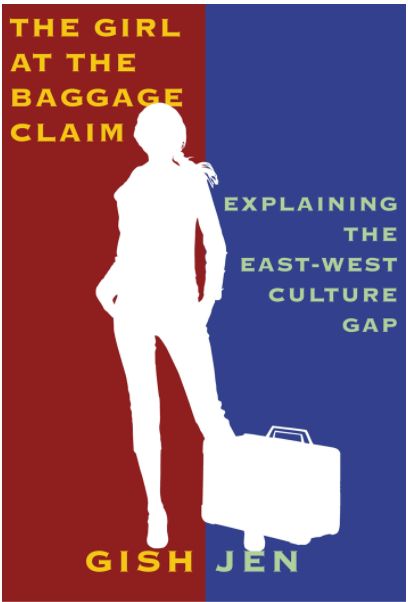
The acclaimed author Gish Jen brings a novelist’s understanding heart and a scholar’s appreciation for data to her new book on the cultural differences between East and West, and the sympathetic perspective of someone who has been both an insider and an outsider in both. The Girl at the Baggage Claim: Explaining the East-West Culture Gap is a wise, impeccably researched, beautifully written, and vitally important book that illuminates the fundamental differences — and the even more profound connections — between what she calls the “big pit” notions of Western individualism and the “flexi-self” ideas of the East that focus more on the group. In an interview, Jen explained those terms and how different notions of the obligations and opportunities in our lives affect our choices and our ability to function in a global community.
You describe the more individualistic, freedom-focused western character as “big pit” and the more cooperative, duty-focused Asian character as “flexi-self.” What do you mean, and why do you like those terms?
I like them because, while they do represent two ends of a spectrum, they do not seem as irreconcilably opposed as terms like “individualistic” and “collectivistic” or “independent” and “interdependent” – opening the door to the idea that one is not necessarily one or the other, but can, paradoxically, be both. They are also more concrete and less loaded. And, most importantly, these names steer the reader away from the idea that one sort of self is capable of independent action while the other is not.
That makes sense. We see people from regions we know to be collectivistic – that is, flexi-self – take independent action all the time.
Exactly. They take trips abroad by themselves. They take up the saxophone. They found soup kitchens. They write books. What differs is what we feel most important. Do we believe that we possess, like an avocado, a big pit at our core, to which we must above all be true? Are we oriented toward its expression and interested in establishing its uniqueness? Or do we believe that while people are of course different, our difference is not what matters most? Do we more importantly serve some larger purpose or entity – a family, a religion, a nation, an artistic tradition—for which we are prepared to make sacrifices?
We all have immigration on their minds these days. Viewed through the lens of your book, it seems that we ought to welcome immigrants not only on principle and because they start so many businesses, but because they stand to make critical contributions to America.
Absolutely. Of course, we have many flexi-selves in America: while individualistic, big pit narratives dominate our culture, a great many groups – including many members of the working class, many Southerners, many Eastern European Americans, many Hawaiians, many Marines, many Catholics, many Buddhists, and more—have a flexi-self side. And not every immigrant has a flexi-self. However, the dominant self in America remains the big-pit self, and where flexi-selves dominate the rest of in the world, immigration is a source of significant perceptual diversity, for starters.
Do you mean that the different selves have different perceptual tendencies?
Yes. Of course, tendencies are only tendencies. But just as the big pit self tends to focus narrowly and intensely on its desires and potential, and to see itself as eminently separable from its context, it also tends to view any given matter in the same way. It tends to view things in isolation, and to favor analytical modes of thought. Similarly, just as a flexi-self focuses on its role in a larger whole, and does not see itself as easily separable from its context, so it tends to view any give matter in context, and to favor more holistic modes of thought – focusing, for example, on patterns and other things requiring a wide-angle focus.
And, of course, both ways of seeing are simultaneously revealing and concealing. So it’s no surprise that the strongest society will be one in which we have perceptual diversity. It will also be the society in which we have a diversity of models when it comes to things like living arrangements.
Do living arrangements in America reflect our big pit selves?
Yes. Here in Boston, for example, we have a lot of triple decker housing. These are associated with an old world model of living – with grandparents on one floor, parents on another, children on another. It is a mark of assimilation to move out of these houses; it’s seen a kind of natural progression. Yet the younger generation often does so only to struggle with isolation. They struggle, too, with the sheer workload of their lives. If they have kids, they struggle with childcare issues. And as their parents age, they struggle to take care of their parents from afar.
Does that mean they should never have moved out? No. The old world family structure can be too confining for many. And for some people, a studio apartment in New York is perfect. But a writer friend who lives with his extended Greek family says that he often feels there is something un-American about it, and should he feel that way? Should not both options should be open to us, and everything in between?
It does seem that many of us boomers are now struggling to care for our parents.
It’s everyone’s story. And this is another place where having a flexi-self side can be a help. A friend recently complained that he wanted to love taking care of his mother—that he wanted to do it with joy, to feel the circle of life coming around. But he had a difficult relationship with his mother even before she became demented, and now it was worse. So there was no feeling of fulfillment, just anger and resentment.
And, of course, many flexi-selves feel anger and resentment toward their parents, too. But less oriented as they are toward self-fulfillment and toward choice, they just do their duty, and don’t expect it to be the joyous expression of their being it perhaps can’t be—which is, in its own way, liberating.
So if we ask ourselves what the advantages and disadvantages of the big pit self might be, we might want to put freedom in the advantage column, but you see a kind of liberation in the flexi-self as well.
I do. The big pit self is free in the sense that it makes more choices. It expresses itself more freely. It considers other people,, but often only if reminded of them; its default assumption is that it operates by its own lights. Yet in experiments like one conducted by Shinobu Kitayama of the University of Michigan, the pit self shows signs of anxiety when making choices, even if there is no one watching. The cultural mandate to define oneself attends its every action, public or private.
The flexi-self, on the other hand, shows signs of anxiety when making choices in the presence of others; it feels the pressure of society’s gaze. But when that gaze is removed, the pressure is removed, too. It is free in a way the pit self is not; it is unselfconscious.
So each model of self has a kind of freedom. The nature of the freedom differs, however, and it’s no surprise that the freedom we cherish is not necessarily cherished by others. Of course, the world is in endless flux, and individualism is on the rise, so others may come to see freedom, American style with less ambivalence in time. But for now, it is often just parts of our freedom they envy.
